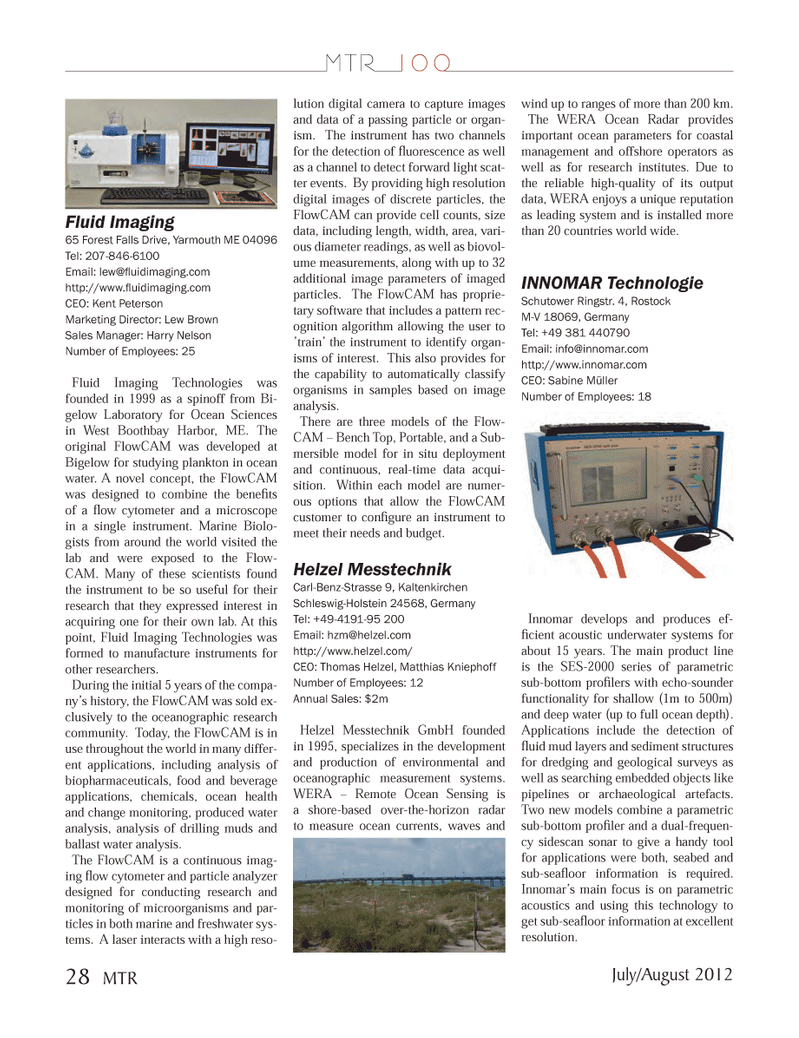
Page 28: of Marine Technology Magazine (July 2012)
MTR 100
Read this page in Pdf, Flash or Html5 edition of July 2012 Marine Technology Magazine
Fluid Imaging65 Forest Falls Drive, Yarmouth ME 04096 Tel: 207-846-6100 Email: lew@ ß uidimaging.comhttp://www. ß uidimaging.comCEO: Kent Peterson Marketing Director: Lew Brown Sales Manager: Harry Nelson Number of Employees: 25 Fluid Imaging Technologies was founded in 1999 as a spinoff from Bi- gelow Laboratory for Ocean Sciences in West Boothbay Harbor, ME. The original FlowCAM was developed at Bigelow for studying plankton in ocean water. A novel concept, the FlowCAM was designed to combine the beneÞ ts of a ß ow cytometer and a microscope in a single instrument. Marine Biolo-gists from around the world visited the lab and were exposed to the Flow- CAM. Many of these scientists found the instrument to be so useful for their research that they expressed interest in acquiring one for their own lab. At this point, Fluid Imaging Technologies was formed to manufacture instruments for other researchers.During the initial 5 years of the compa-nyÕs history, the FlowCAM was sold ex- clusively to the oceanographic research community. Today, the FlowCAM is in use throughout the world in many differ- ent applications, including analysis of biopharmaceuticals, food and beverage applications, chemicals, ocean health and change monitoring, produced water analysis, analysis of drilling muds and ballast water analysis. The FlowCAM is a continuous imag- ing ß ow cytometer and particle analyzer designed for conducting research and monitoring of microorganisms and par- ticles in both marine and freshwater sys- tems. A laser interacts with a high reso- lution digital camera to capture images and data of a passing particle or organ- ism. The instrument has two channels for the detection of ß uorescence as well as a channel to detect forward light scat- ter events. By providing high resolution digital images of discrete particles, the FlowCAM can provide cell counts, size data, including length, width, area, vari- ous diameter readings, as well as biovol- ume measurements, along with up to 32 additional image parameters of imaged particles. The FlowCAM has proprie- tary software that includes a pattern rec- ognition algorithm allowing the user to ÕtrainÕ the instrument to identify organ- isms of interest. This also provides for the capability to automatically classify organisms in samples based on image analysis.There are three models of the Flow- CAM Ð Bench Top, Portable, and a Sub- mersible model for in situ deployment and continuous, real-time data acqui-sition. Within each model are numer- ous options that allow the FlowCAM customer to conÞ gure an instrument to meet their needs and budget. Helzel MesstechnikCarl-Benz-Strasse 9, Kaltenkirchen Schleswig-Holstein 24568, Germany Tel: +49-4191-95 200 Email: [email protected]://www.helzel.com/ CEO: Thomas Helzel, Matthias Kniephoff Number of Employees: 12 Annual Sales: $2mHelzel Messtechnik GmbH founded in 1995, specializes in the development and production of environmental and oceanographic measurement systems. WERA Ð Remote Ocean Sensing is a shore-based over-the-horizon radar to measure ocean currents, waves and wind up to ranges of more than 200 km. The WERA Ocean Radar provides important ocean parameters for coastal management and offshore operators as well as for research institutes. Due to the reliable high-quality of its output data, WERA enjoys a unique reputation as leading system and is installed more than 20 countries world wide. INNOMAR Technologie Schutower Ringstr. 4, Rostock M-V 18069, Germany Tel: +49 381 440790 Email: [email protected] http://www.innomar.com CEO: Sabine MüllerNumber of Employees: 18 Innomar develops and produces ef- Þ cient acoustic underwater systems for about 15 years. The main product line is the SES-2000 series of parametric sub-bottom proÞ lers with echo-sounder functionality for shallow (1m to 500m) and deep water (up to full ocean depth). Applications include the detection of ß uid mud layers and sediment structures for dredging and geological surveys as well as searching embedded objects like pipelines or archaeological artefacts. Two new models combine a parametric sub-bottom proÞ ler and a dual-frequen- cy sidescan sonar to give a handy tool for applications were both, seabed and sub-seaß oor information is required. InnomarÕs main focus is on parametric acoustics and using this technology to get sub-seaß oor information at excellent resolution.28 MTRJuly/August 2012 MTR #6 (18-33).indd 28MTR #6 (18-33).indd 288/1/2012 1:30:09 PM8/1/2012 1:30:09 PM

 27
27

 29
29
